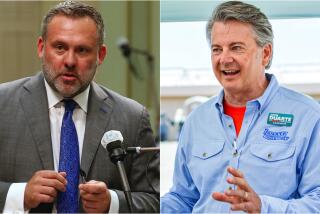‘Top two’ shakes it up
- Share via
When Rep. Gary Miller this week became the latest California congressman to throw in the towel, the Rancho Cucamonga Republican in effect delivered his district into Democrats’ hands.
While Miller’s is the only one of the five open House seats in California that analysts say is likely to flip from one major party to the other in this year’s elections, the state’s relatively new “top two” primary system is helping to reshape all of them.
Contests in districts dominated by one major party, once essentially settled in primaries, could now continue into the fall. With the candidate fields still taking shape, those might include the races to succeed Republicans Howard P. “Buck” McKeon in northeast Los Angeles County and John Campbell in Orange County, for example.
The battle to succeed Henry Waxman on the coastal side of L.A. County could open the door -- at least in the primary -- to an independent with enough money and backing to overcome the Democrats’ registration edge.
Jim Mayer, who heads a nonpartisan good-government group that pushed for the top-two primary, said the open congressional races could help show how well it is working two years after its inauguration. The top two finishers in the primary now advance to November, regardless of any party affiliation, and all voters can choose among all candidates.
“The thing to watch will be where do these candidates position themselves,” said Mayer, chief executive of California Forward.
Will they address voters’ priorities? Will they be pragmatists, willing to compromise? Or will they put party platform and ideology first?
“The question embedded in the new rules is, who are you going to represent?” Mayer said.
Two years ago, the “jungle” primary produced 10 congressional and 20 other fall elections that for the first time pitted members of the same party against one another.
Among them was the race for Miller’s increasingly Democratic 31st Congressional District in the Inland Empire. Four Democrats split the primary vote, allowing Miller and the other Republican to move on to the general election.
Miller would have faced much tougher odds this year because it was highly unlikely that the situation would repeat itself. In addition, district voters chose Democrats in most other races in 2012.
Although two Republicans, San Bernardino City Councilman John Valdivia and military veteran and businessman Paul Chabot, have said they would run for the seat, most observers expect that GOP campaign money will now go to other districts with better prospects.
The Democratic establishment is backing Redlands Mayor Pete Aguilar for the seat.
Other Democrats in the race are former Rep. Joe Baca of Rialto, Colton attorney Eloise Gomez Reyes and San Bernardino school board member Danny Tillman.
Most voters still have trouble distinguishing among candidates except by party label, said UC San Diego political scientist Thad Kousser.
“That means the hope of the top-two is very hard to realize if voters can’t figure out how to spot the moderate,” he said. “It also will take a while for independent voters to realize they can play a role in primaries now.”
Those factors represent the challenge faced by three Republicans considering a bid to replace GOP Rep. John Campbell of Irvine in the 45th District, a party stronghold. The race may come down to name identification and campaign mail rather than differences in ideology, Kousser said.
And in McKeon’s 25th District, which still tilts Republican despite changing demographics, a potentially large field could add to voters’ confusion.
The better known of the Republicans who have announced for the race are state Sen. Steve Knight of Palmdale and former state legislator Tony Strickland. Among the Democrats is Lee Rogers, whom McKeon defeated by 10 percentage points in 2012.
Campaigns are developing strategies to help candidates adjust to the new system. One is to discourage competitors, especially in an intraparty fight, by declaring early and lining up a lot of backing right away.
State Sen. Mark DeSaulnier (D-Concord) used that technique to help clear the field of potential competitors for Rep. George Miller’s solid blue 11th District in the Bay Area.
“We announced right away, then burned up the phone lines, trying to get every key endorsement,” said Dave Jacobson, a consultant with Los Angeles-based Shallman Communications who is working for DeSaulnier.
Two potential candidates, Democratic Assemblywomen Susan Bonilla of Concord and Joan Buchanan of Alamo, did not get in and endorsed DeSaulnier.
DeSaulnier’s strategy was not entirely successful for state Sen. Ted Lieu of Torrance, the first Democrat to stake a claim in Waxman’s Westside-South Bay 33rd District. He announced the day after Waxman’s retirement announcement.
Although three other well-known Democrats then took a pass, former L.A. Controller Wendy Greuel jumped in almost as soon as Lieu did. Columnist and radio show host Matt Miller announced his candidacy Friday. Other, less-known Democrats also entered.
A Republican and two independents are also running. Bestselling author and spiritual teacher Marianne Williamson, one of the independents, has been drawing large audiences at campaign events for months and has reported raising more than $350,000.
--
More to Read
Get the L.A. Times Politics newsletter
Deeply reported insights into legislation, politics and policy from Sacramento, Washington and beyond. In your inbox twice per week.
You may occasionally receive promotional content from the Los Angeles Times.











